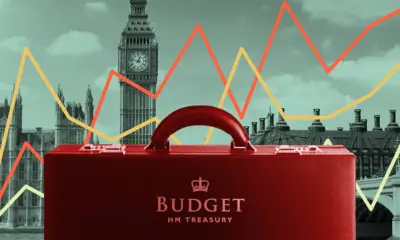Business
The Resilience of Britain’s Economy: Signals from Trade, Investment, and Consumer Trends

Introduction
The British economy has faced a challenging environment over the past few years. From pandemic recovery and global supply disruptions to energy shocks and inflationary pressures, few developed nations have navigated such a complex combination of external and domestic risks. Yet despite these obstacles, recent data show that the United Kingdom has demonstrated a surprising degree of resilience.
Trade diversification, stable investment flows, and steady consumer behaviour are all contributing to this endurance. While the growth outlook remains moderate, the evidence suggests that Britain’s economic structure retains flexibility and adaptability. Understanding how these forces interact offers valuable insight into the nation’s capacity to sustain recovery and remain competitive in a shifting global landscape.
Trade Performance and Market Realignment
Trade remains one of the most accurate barometers of economic vitality. Since leaving the European Union, the UK has undergone a structural realignment in its trade relationships. Early disruptions in logistics and regulatory procedures have given way to new patterns of commerce, particularly with non-European partners.
Exports to North America and the Asia-Pacific region have expanded, driven by services such as finance, consulting, and technology. The signing of the Comprehensive and Progressive Agreement for Trans-Pacific Partnership marked a symbolic and practical step toward global integration beyond Europe. Simultaneously, imports have diversified, reflecting the country’s adaptation to changing supply chains.
Challenges persist, especially for small and medium-sized enterprises that continue to face bureaucratic costs when trading with the EU. However, larger firms have adapted by building digital platforms for customs and supply management. This technological response highlights the resilience of British businesses and their ability to maintain competitiveness through innovation rather than reliance on legacy trade routes.
Investment Trends and Capital Flow Stability
Investment remains a cornerstone of economic confidence. The UK continues to attract foreign capital despite global uncertainty, underpinned by its legal predictability and strong financial infrastructure. London retains its position as one of the world’s leading destinations for venture and private equity investment.
Technology, clean energy, and life sciences have emerged as priority sectors for both domestic and foreign investors. The government’s continued emphasis on green growth and digital transformation has fostered stability even as global markets fluctuate. Major infrastructure projects, including renewable energy hubs and transport upgrades, signal long-term commitment to productivity.
Institutional investors are increasingly integrating sustainability criteria into their portfolios. This shift aligns capital deployment with broader environmental goals while enhancing the credibility of British markets. The adoption of advanced benchmarking and data analytics across the investment sector has improved transparency and risk assessment, reinforcing London’s reputation for financial discipline.
Although capital inflows remain positive, the UK must continue addressing regional disparities. Investment tends to concentrate in London and the South East, while other regions compete for attention and resources. Strengthening local investment ecosystems through targeted incentives and infrastructure spending will be essential to spreading economic resilience more evenly.
Consumer Trends and Household Adaptation
Household consumption remains the largest driver of the UK economy, accounting for nearly two-thirds of GDP. Over the past two years, consumers have faced a sharp rise in living costs due to energy price shocks and higher borrowing rates. Yet spending patterns suggest a gradual adaptation to these challenges.
Retail data show modest growth in essential categories and digital commerce, even as discretionary spending has slowed. Consumers are adjusting priorities rather than retreating entirely. The acceleration of digital payments, online services, and subscription-based models indicates that demand continues to evolve rather than contract.
Real wage growth, though uneven, has begun to stabilize as inflation recedes. This improvement, combined with strong labour market participation, supports a base level of consumption that sustains the broader economy. Credit conditions remain tight but manageable, with banks reporting stable repayment levels and limited distress in consumer lending.
Psychologically, British consumers have demonstrated resilience through behavioural flexibility. Savings accumulated during the pandemic have provided a temporary cushion, and many households are reallocating resources to manage higher mortgage or rent costs. The overall pattern reflects pragmatism rather than pessimism, reinforcing the idea that resilience stems from adaptation at both institutional and individual levels.
Sectoral Strengths and Industrial Adjustment
The composition of the UK economy contributes significantly to its endurance. Services, which represent more than three-quarters of GDP, have proven less sensitive to short-term fluctuations in commodity prices and global supply disruptions. Financial services, technology, and professional consulting continue to anchor export earnings and employment.
Manufacturing, while smaller in scale, has benefited from nearshoring trends as firms seek greater control over supply chains. Automotive and aerospace sectors are investing in advanced materials and electric mobility to align with global energy transitions. The government’s incentives for research and development are fostering competitiveness in high-value manufacturing.
The creative industries, including media, design, and digital entertainment, have also shown robust growth. Their combination of innovation and export potential contributes to both economic diversity and cultural influence. These strengths collectively buffer the economy against shocks that might otherwise have deeper structural consequences.
Fiscal and Monetary Policy Coordination
Economic resilience also depends on coherent policy coordination. The Bank of England has pursued a cautious approach to inflation management, gradually stabilizing interest rates after a period of aggressive tightening. Fiscal policy, meanwhile, has focused on targeted support for households and investment-driven recovery programs.
Maintaining this balance between restraint and stimulus remains a delicate task. Premature loosening of policy could reignite inflation, while excessive tightening risks undermining fragile recovery. The Treasury’s emphasis on productivity-enhancing investment and public service reform reflects an understanding that long-term resilience requires both financial discipline and structural renewal.
Continued policy clarity is essential for investor confidence. Markets respond positively to predictability and transparency. The UK’s fiscal credibility, though tested by political transitions, remains anchored by institutional strength and a robust financial governance framework.
External Risks and Global Interdependence
While Britain’s domestic fundamentals are stabilizing, external risks persist. Global trade tensions, energy price volatility, and regional conflicts could disrupt supply chains and market sentiment. The interconnected nature of the British economy means that global shocks transmit quickly through financial channels.
The ability to mitigate these risks depends on maintaining flexible trade alliances and a proactive diplomatic approach. The UK’s engagement in digital trade and climate finance initiatives provides a strategic cushion against external uncertainty. Collaborations with partners in North America, the Gulf, and Asia are deepening economic diversification.
Adaptability, rather than insulation, remains the guiding principle. As capital flows shift globally toward emerging markets and technology hubs, Britain’s focus on innovation and regulatory clarity will be key to preserving relevance and competitiveness.
Conclusion
The resilience of Britain’s economy lies not in immunity to shocks but in its capacity to adapt, absorb, and evolve. Trade diversification, targeted investment, and steady consumer behaviour are collectively stabilizing forces. Policymakers face the ongoing challenge of balancing monetary prudence with fiscal innovation, ensuring that recovery is inclusive and sustainable.
While headwinds remain, Britain’s long-standing institutional credibility, technological strength, and entrepreneurial culture provide a strong foundation for continued stability. The coming years will test the depth of that resilience, but current signals indicate a nation capable of renewal. Economic endurance is not static; it is a product of adaptability, foresight, and shared confidence in the system that underpins prosperity.




















